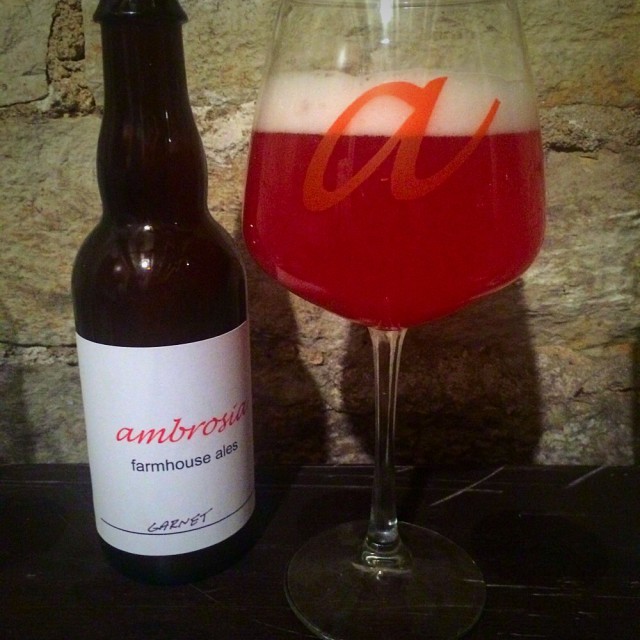Background and tasting notes for a blonde sour (Citrine Batch 5) aged on tart cherries.
While at this point I've done plenty of fruited saisons (Demeter Auran, Demeter Vert, Demeter Sinis (Cranberry), Demeter Spectre, etc.), this was only my second time preparing fruited sours. The first was way back when I blended the first three batches of Citrine, adding gooseberries, rhubarb, blueberries, and kiwi to different portions. The gooseberry version was a disaster, as the puree that I purchased tasted more like twigs than any sort of gooseberry that I've ever tried. The blueberry version was okay, just a bit plain without enough funk and acidity to back up the berry flavor. The kiwi and rhubarb versions were both quite good, in my opinion, and are something I need to get back to. Luckily, after a few trips to farms around Michigan last summer, I have a decent stockpile of fruit to work through.
This beer went more traditional, using Montmorency tart cherries from a farm in Southwest Michigan. Alongside this, I also added black raspberries to a Flanders Red to create Amethyst, a beer I'll have notes on in the future. Amarelle and Morello are the two main tart cherries types grown in the United States. Montmorency cherries, a type of Amarelle, don't give nearly as deep of a red color as Balaton, a type of Morello, because while the skins of Amarelle cherries are bright red, the insides are more of a pale yellow. In contrast, with Morello cherries, both the skin and flesh are dark. That's why Garnet, pictured below, isn't that deep red color one often expects from a kriek, even though I used a typical ratio of two pounds of fruit per gallon of beer (actually two pounds of fruit per gallon of available fermentor space, filling to the top with aged blonde sour).
The process for this one was relatively simple. I took roughly 3 gallons of the ECY20 version of that Citrine batch and transferred onto 6 pounds of tart cherries that we picked up in Michigan over Fourth of July weekend, all in a 3-gallon Better Bottle. This Citrine base was lightly acidic, but a little plain. The was pH down to only 4.2, even with gravity at 1.002. Some faint melon character. I was hoping the cherries will add some depth and acidity, especially with the inclusion of the pits. While I took a bit of a gamble here not having the most interesting Citrine base, I also thought that the beer would have time to evolve while the cherries fermented away, and I didn't want to go with a base that was too acidic, as I still wanted the base beer to be quite drinkable, as I really loathe overly-acidic beers, particular when acetic acid becomes involved. As indicated in the notes below, I may have been a little too conservative using a "bland" base as the resulting beer could certainly use more depth, but the acidity is just where I want it and the drinkability is quite high.
Appearance: Bright deep pink with a nice bubbly head. Pretty clear beer without much, if any, fruit sediment, as the cherries stayed mostly intact during the secondary fermentation period and through the transfer.
Nose: Bright cherry with a bit of skin. Backing wheat with some lemon and moderate acidity. Could use a bit more funk, and also potentially a cherry blend. Next time I'll consider going with a blend of Montmorency and Balaton, both of which I'll hopefully be able to find this summer. I won't have that problem in a few years, as my wife and I will be planting Montmorency and Balaton cherry trees in our backyard this spring, alongside a new apricot tree and a few cider trees that we planted last year.
Flavor: Similar to nose with a bit more lemon. Definite cherry dominance. Could use more earth and skin with more-pronounced Brett and funk. This would work really well with just a bit of something like Ruby, for a bit more funk and earthiness. As it warms, there's just a bit of biscuit and pie crust in the background rounding out the flavor profile.
Mouthfeel: Very light and crisp and moderate acidity. Super clean lactic character with just a bit of lemon juice. Moderate carbonation. Could maybe use just a bit more, though doesn't need to be at saison levels. Super clean, falling off the palate quickly after swallowing.
Overall: A bit simple, but I really like it for what it is. As detailed above, this wasn't the most-inspiring Citrine base and was fairly young, but is a great showcase for the profile of these cherries. With just a bit more depth, and an increased cherry ratio or blend, this could be a really winner. I would maybe even increase the cherries by 50% if using straight Montmorency again. I could see doing a little blend with this for a future beer in the Science & Art series, blending with a Flanders Red, or putting a bit into a blonde Brett saison to add a bit of extra fruit character.

No comments:
Post a Comment